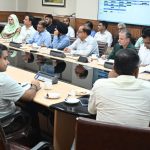Nearly 39 percent of sanctioned posts for doctors and medical officers in Primary Health Centres (PHCs) across rural Jammu and Kashmir are lying vacant, according to the Union Ministry of Health and Family Welfare’s latest report.
The ‘Health Dynamics of India: Infrastructure and Human Resources 2022-23’ reveals that of the 1,677 sanctioned posts in rural PHCs, only 1,030 doctors are currently in position, leaving 647 posts unfilled—a significant manpower gap that continues to affect the delivery of healthcare in remote areas.
Jammu and Kashmir has 890 PHCs in rural regions, of which 690 operate from government-owned buildings, 192 from rented spaces, and 8 from panchayat or other structures. The report, tabled in Parliament in response to questions in the LokSabha, notes that at least 200 new PHC buildings need to be constructed to meet the region’s primary healthcare needs.
According to the report, there is a sanctioned strength of 882 posts for Female Health Workers/ANMs, of which 746 are currently in position, while 116 posts are vacant.
The Health Dynamics of India report also revealed that out of a sanctioned strength of 951 pharmacists, 707 are in position and 244 posts remain vacant in rural PHCs in the UT.
Similarly, there is a sanctioned strength of 514 laboratory technicians out of which 414 are in position and rest are vacant. The report added that the PHCs require 890 posts.
The report, which also mentions shortage of nursing staff said there are 735 posts of nursing staff of which 558 are in position and 177 are vacant in the PHCs.
It also stated that out of 890 PHCs in the rural areas, only 187, which accounts for 21 percent, operate 24/7. Additionally, 29 percent have labour rooms, just 0.2 percentare equipped with an operation theatre, and 281 PHCs (42 percent) have at least four beds.
The report stated that 95 PHCs (10 percent) are without electricity supply, 59 PHCs (6.6 percent) lack proper water supply, and 102 PHCs (11 percent) do not have an all-weather motorable approach road. Only 336 PHCs (37 percent) are equipped with a computer.
As per the report, out of the 890 PHCs, only 501 have separate toilets for male and female patients, highlighting the urgent need for action to improve basic sanitation facilities in these health institutions.
The inadequate healthcare facilities at PHCs are a common issue in rural areas of Jammu and Kashmir, despite the expansion of government schemes. As a result, many patients are forced to travel to district or sub-district hospitals for the treatment of even minor ailments.
The “Health Dynamics of India: Infrastructure and Human Resources” report was earlier known as Rural Health Statistics (RHS). It holds significant importance as it acts as a crucial source of information for decision-making and policy intervention and monitoring the status of public health infrastructure and human resources of India.
The report provides data on health infrastructure including manpower. The publication is based on data provided by the States/UTs. The data has been analyzed and cross-checked for consistency and also validated with the data available from other sources.








